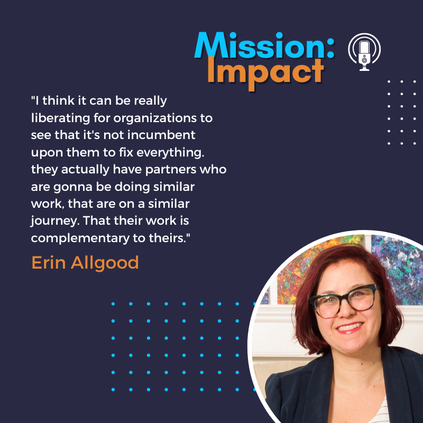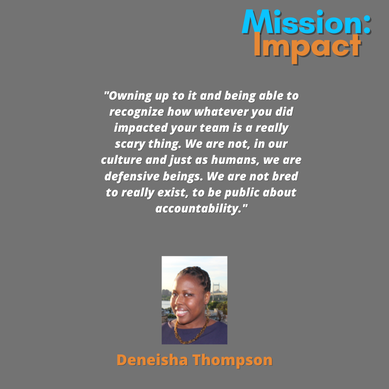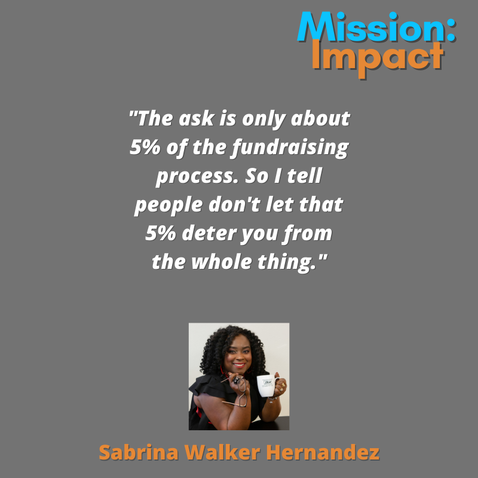Mission: Impact podcast & blog
Build a better world without becoming a martyr to your nonprofit cause
Listen on:
 In episode 76 of Mission: Impact, Carol Hamilton and Erin Allgood discuss
Guest Bio: Erin Allgood helps organizations and individuals who give a damn create real impact. As the founder of Allgood Strategies, Erin helps socially-conscious organizations with strategic planning, organizational development, and leadership coaching. Her services focus on catalyzing social change at the systems, organizational, and individual levels. Important Links and Resources:
Click "Read More" for Transcript:  In episode 58 of Mission: Impact, Carol and her guest, Deneisha Thompson discuss:
A licensed social worker turned social entre/edupreneur, Deneisha Thompson is a consultant, facilitator and coach who specializes in change management, leadership development, group facilitation, and building strong teams. She is the founder of 4 Impact Consulting, a social impact firm, that provides culture-influencing organizational development services focused on building, repairing and positioning nonprofit teams for impact and growth. Important Links and Resources:
 In episode 26 of Mission: Impact, some of the topics that Carol and her guest, Sabrina Walker Hernandez discussed include:
Sabrina Walker Hernandez is the President & CEO of Supporting World Hope. She has over 25 years of experience in nonprofit management, fundraising, and leadership. One of Sabrina’s greatest successes is that she increased operation revenue from $750,000 to $2.5 million over an 8-year period as well as being responsible for the planning and operations of a $12 million comprehensive capital campaign in the 3rd poorest county in the United States. She has also facilitated numerous workshops with hundreds of nonprofit professionals and is a master trainer for the Boys & Girls Clubs of America. Sabrina is certified in Nonprofit Management by Harvard Business School. She is an active community leader and volunteer in Edinburg, Texas where she is based. Important Guest Links:
Click "Read More" for Transcript:  In episode 17 of Mission: Impact, some of the topics that Carol and her guest, Wendy Wolff discussed include: - How leading a non-profit differs from leading a for-profit business - Awareness vs. action - Why people are scared of evaluation - Assumptions to avoid when working with communities - Changing social norms - Where to start evaluation on an organizational level - The barriers to evidence-based testing Guest Information: Activating and coordinating community responses to the HIV/AIDS epidemic was how Wendy Wolff began her career in the nonprofit sector. Her early career helped her to build a strong understanding about the value and role of the community in program planning and policy development. She brings nearly 25 years of diverse consulting experiences to her role as Director of Strategic Engagement for Maryland Nonprofits. Wendy has collaborated with government agencies; universities; non-profit organizations; and faith-based organizations to enhance the quality of life within many communities throughout the United States. She uses her strategic thinking skills to help clients synthesize information from wide-ranging sources, reframe problems while uncovering root causes to find refreshing, creative and effective solutions. Over the past two decades, Wendy has helped thousands of organizations and their people to create brighter futures for the communities in which they serve. Her excitement in working with the members of Maryland Nonprofit’s is infectious. She values the genius that each and every person brings to their role in the sector and works diligently to elevate any person that she engages with. Ms. Wolff holds a Master’s Degree in Public Health from New York University. She has resided as an Adjunct Professor at the University of Denver and as an Associate Faculty Member at Indian River State College. Wendy is a licensed consultant with the Standards for Excellence® Institute. Ms. Wolff’s first book, The Letter Writing Project (Blooming Twig Books), was published in August 2014. Evaluation Resources
Click "Read More" for Transcript: |
Archives
April 2024

Grace Social Sector Consulting, LLC, owns the copyright in and to all content in and transcripts of the Mission: Impact podcast, as well as the Mission: Impact blog with all rights reserved, including right of publicity.
|
Telephone301-857-9335
|
info[at]gracesocialsector.com
|
Grace Social Sector Consulting, LLC, owns the copyright in and to all content in, including transcripts and audio of the Mission: Impact podcast and all content on this website, with all rights reserved, including right of publicity.
|